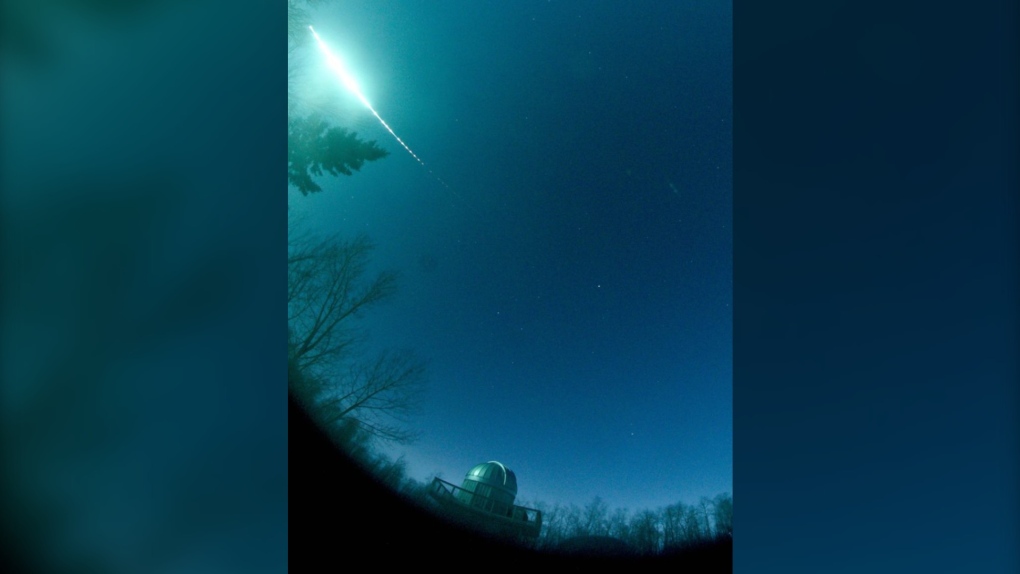Alberta fireball challenges theories of solar system's origin: Western University
A fireball over the skies of central Alberta last year captured the attention of international researchers, including astronomers at London, Ont.’s Western University. On Monday, the university announced that the cosmic origins of this particular meteoroid is now “challenging” long-held beliefs about the origins of the solar system.
According to a press release from Western University, in 2021 an international team of scientists, stargazers, and professional and amateur astronomers led by meteor physicists at Western captured photos and videos of a rocky meteoroid that hurtled through the skies over central Alberta as a spectacular fireball.
Researchers have since concluded that the object’s original point of origin is “smack dab” in the middle of something known as the “Oort cloud.”
The Oort cloud is located billions of kilometres away from Earth on the edge of the solar system, and is a cosmic collection of icy objects.
Sometimes these icy objects are put on a trajectory with the inner solar system and the sun, where they are viewed as comets. Western said scientists have not yet viewed any objects in the Oort Cloud directly, “but everything detected so far coming from its direction has been made of ice.”
According to Western, the discovery of the Alberta fireball’s rocky origins from the outer solar system is a “game changer” when it comes to the origins of our solar system.
“Theoretically, the very basis of understanding our solar system’s beginnings is built upon the foundation that only icy objects exist in these outer reaches and certainly, nothing made of rock,” the release reads.
For Denis Vida, a Western meteor physics postdoctoral researcher, the implications of this discovery are truly out of this world.
 The fireball captured by the Global Fireball Observatory camera at Miquelon Lake Provincial Park, Alberta. (Source: University of Alberta)
The fireball captured by the Global Fireball Observatory camera at Miquelon Lake Provincial Park, Alberta. (Source: University of Alberta)
“This discovery supports an entirely different model of the formation of the Solar System, one which backs the idea that significant amounts of rocky material co-exist with icy objects within the Oort cloud,” explained Vida. “This result is not explained by the currently favoured solar system formation models. It’s a complete game changer.”
According to Western, all previous rocky fireballs have originated from much closer to Earth. Therefore, the meteoroid at the centre of the Alberta fireball is of particular interest to researchers.
Global Fireball Observatory cameras, developed in Australia and operated by the University of Alberta, observed the approximately two kilogram rocky meteoroid enter the atmosphere. Researchers at Western then calculated that it was travelling on an orbit typically reserved for icy comets travelling from the far out Oort cloud.
During its descent, Western said the Alberta fireball travelled much deeper into the atmosphere than icy objects, and it broke apart exactly like a rocky meteoroid would. Comets however are made of ice and dust, and therefore vaporize as they approach the heat of the sun — this causes a comet’s distinctive tail.
Based on these findings, researchers concluded the Alberta fireball was made of rock.
“We want to explain how this rocky meteoroid ended up so far away because we want to understand our own origins. The better we understand the conditions in which the solar system was formed, the better we understand what was necessary to spark life,” said Vida. “We want to paint a picture, as accurately as possible, of these early moments of the solar system that were so critical for everything that happened after.”
The findings from the Alberta fireball were publishing Monday in Nature Astronomy.
CTVNews.ca Top Stories

opinion Tom Mulcair: Prime Minister Justin Trudeau's train wreck of a final act
In his latest column for CTVNews.ca, former NDP leader and political analyst Tom Mulcair puts a spotlight on the 'spectacular failure' of Prime Minister Justin Trudeau's final act on the political stage.
B.C. mayor gets calls from across Canada about 'crazy' plan to recruit doctors
A British Columbia community's "out-of-the-box" plan to ease its family doctor shortage by hiring physicians as city employees is sparking interest from across Canada, says Colwood Mayor Doug Kobayashi.
'There’s no support': Domestic abuse survivor shares difficulties leaving her relationship
An Edmonton woman who tried to flee an abusive relationship ended up back where she started in part due to a lack of shelter space.
opinion King Charles' Christmas: Who's in and who's out this year?
Christmas 2024 is set to be a Christmas like no other for the Royal Family, says royal commentator Afua Hagan. King Charles III has initiated the most important and significant transformation of royal Christmas celebrations in decades.
Baseball Hall of Famer Rickey Henderson dead at 65, reports say
Rickey Henderson, a Baseball Hall of Famer and Major League Baseball’s all-time stolen bases leader, is dead at 65, according to multiple reports.
Arizona third-grader saves choking friend
An Arizona third-grader is being recognized by his local fire department after saving a friend from choking.
Germans mourn the 5 killed and 200 injured in the apparent attack on a Christmas market
Germans on Saturday mourned the victims of an apparent attack in which authorities say a doctor drove into a busy outdoor Christmas market, killing five people, injuring 200 others and shaking the public’s sense of security at what would otherwise be a time of joy.
Blake Lively accuses 'It Ends With Us' director Justin Baldoni of harassment and smear campaign
Blake Lively has accused her 'It Ends With Us' director and co-star Justin Baldoni of sexual harassment on the set of the movie and a subsequent effort to “destroy' her reputation in a legal complaint.
Oysters distributed in B.C., Alberta, Ontario recalled for norovirus contamination
The Canadian Food Inspection Agency has issued a recall due to possible norovirus contamination of certain oysters distributed in British Columbia, Alberta and Ontario.


































